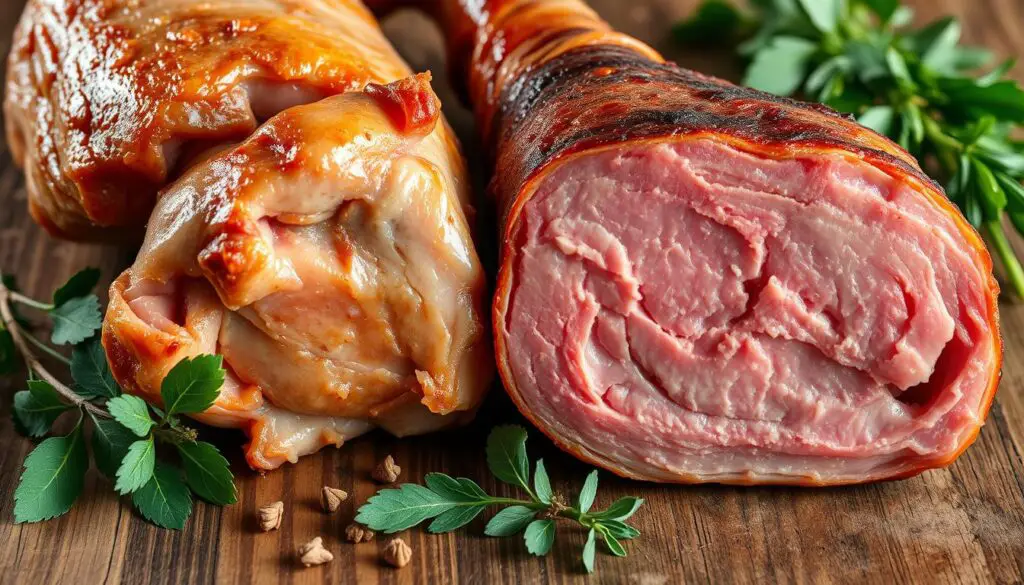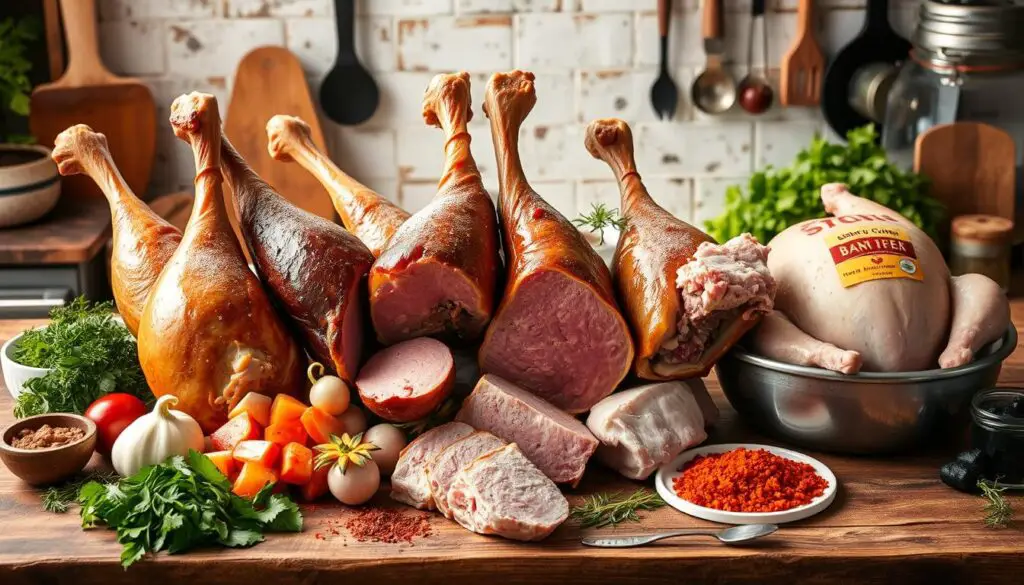Pork hock and ham hock might seem alike, but they come from different parts of the pig. They also have unique tastes and uses in cooking. Knowing the differences can help you pick the right one for your recipes.
We’ll explore where they come from, how to prepare them, and their flavors. This will help you feel more confident when shopping for meat. You’ll also learn how to make your dishes even better.
What is a Pork Hock?
Pork hock, also known as pork knuckle or pork shank, is a tasty cut from a pig’s leg. It’s known for its unique texture and flavor. This makes it great for many dishes.
Source and Preparation
Pork hocks come from the pig’s leg, just above the foot. When cooked slowly, the meat becomes tender and easy to shred. This makes it perfect for slow-cooked stews and braises.
Flavor and Texture
Pork hocks have a gamey taste due to their leaner meat and strong connective tissues. The meat is meaty and gelatinous, adding richness to dishes. When cooked right, it becomes incredibly tender, making it a great addition to many recipes.
What is a Ham Hock?
Ham hocks come from the upper rear leg of a pig. They are below the thigh and above the foot. These cuts are tough but full of collagen. They are cured and smoked to add flavor, giving them a smoky taste.
This process also makes them juicier and less chewy than pork hocks.
Curing and Smoking Process
The curing and smoking process is key to making ham hocks tasty. First, they are cured with salt to preserve the meat and remove excess moisture. Then, they are smoked over hardwood like hickory or oak.
This step adds a rich, smoky flavor. It makes them perfect for soups, stews, and slow-cooked dishes.
| Key Characteristics of Ham Hocks | Details |
|---|---|
| Source | Upper rear leg of the pig, below the thigh and above the foot |
| Composition | Primarily skin, fat, bone, and collagen |
| Curing Process | Cured with salt to preserve the meat and draw out excess moisture |
| Smoking Process | Smoked over hardwood, such as hickory or oak, to impart a rich, smoky flavor |
| Culinary Uses | Commonly used to flavor soups, stews, and other slow-cooked dishes |
The curing and smoking process makes ham hocks special. It turns them into a unique and flavorful ingredient in the world of pork.
Differences Between Pork Hock and Ham Hock
Pork hocks and ham hocks look similar but are different in many ways. Pork hocks come from the pig’s lower leg. Ham hocks, on the other hand, come from the upper rear leg, known as the ham.
Pork hocks are usually unsmoked. This means they have a stronger, gamier taste. Ham hocks, though, are cured and smoked. This makes them juicier and more flavorful.
| Characteristic | Pork Hock | Ham Hock |
|---|---|---|
| Source | Lower leg of the pig | Upper rear leg (ham) of the pig |
| Preparation | Unsmoked | Cured and smoked |
| Flavor and Texture | Stronger, gamier taste, tougher texture | More juicy and flavorful due to curing and smoking |
Pork hocks need longer cooking times to become tender. This is because they are tougher. Ham hocks, being cured and smoked, cook faster. Knowing these differences helps you choose the right cut for your recipes.
pork hock vs ham hock
Pork hock and ham hock are two different cuts of meat. They come from the pig’s leg but taste and cook differently.
Pork hock, also known as the pork knuckle, comes from the pig’s ankle. It’s great in stews, soups, and braised dishes. Its gelatinous texture and rich flavor add depth to the dish.
Ham hock, on the other hand, comes from the upper rear leg of the pig. It’s cured and smoked to boost its taste. Ham hocks are often used in collard greens, bean soups, and soul food.
| Pork Hock | Ham Hock |
|---|---|
| Derived from the ankle joint of the pig | Derived from the upper rear leg of the pig |
| Commonly used in stews, soups, and braised dishes | Often found in dishes like collard greens, bean soups, and soul food |
| Gelatinous texture and rich, savory flavor | Cured and smoked to enhance flavor |
The way they’re prepared and cut makes pork hock and ham hock perfect for different dishes. Knowing these differences helps you pick the right meat for your recipe. It can also make your cooking better.

Common Culinary Uses
Pork hock and ham hock are key ingredients in many dishes worldwide. They add flavor to stews, soups, and braised dishes. Their rich taste is also great for stocks, broths, and sauces.
Ham hocks are often used in pea soup or collard greens for texture and flavor. Pork hocks, on the other hand, are a staple in German cuisine. They’re used to make Eisbein or Schweinshaxe.
Ham hocks are about four inches long and less expensive than other pork cuts. They’re cured with salt and smoked, giving a salty bacon-like taste.
In American southern cuisine, ham hocks are used in collards or pinto beans. They’re also a key ingredient in Pennsylvania’s scrapple. In Eastern Europe, they’re boiled, roasted, or fried and served whole.
In Germany and Austria, ham hocks are used in schweinshaxe, eisbein, and stelze. Poland’s golonka is a barbecued ham hock. Switzerland and Sweden have wädli and fläsklägg med rotmos respectively.
Chinese cuisine also uses ham hocks in various ways, from fried to stewed. They have a smoky, porky taste similar to bacon but with less fat and more collagen.
Ham hocks are often cheaper than bacon and add less fat to dishes. They’re a cost-effective cut of pork, rich in bone and collagen. Fresh ham hocks need to be kept cold and used within a week unless frozen. They’re usually sold pre-cooked and smoked.
Ham hocks are great for adding flavor to soups and stews. They’re essential in dishes like split pea and ham soup, Capitol Hill Bean Soup, and pork and beans. The ham hock can be cooked with beans for hours, then added back for contrast.
| Culinary Uses of Pork Hock | Culinary Uses of Ham Hock |
|---|---|
|
|
Similarities Between Pork Hock and Ham Hock
Cooking Methods
Pork hock and ham hock come from the pig’s leg. They are both tough and need slow cooking to become tender. This slow cooking breaks down the meat, making it fall-off-the-bone tender.
Both are often braised, simmered, or roasted. The main difference is that ham hocks are smoked or cured before cooking. Pork hocks are usually not.
When cooking pork hock or ham hock, the method is similar. They both do well with low and slow cooking. This can be in a stew, soup, or roasted in the oven until tender.
| Cooking Method | Pork Hock | Ham Hock |
|---|---|---|
| Braising | ✓ | ✓ |
| Simmering | ✓ | ✓ |
| Roasting | ✓ | ✓ |
| Smoking/Curing | ✗ | ✓ |
Pork hock and ham hock are versatile in cooking. They can be used in soups, stews, and roasted meat platters.
How to Cook Pork Hock and Ham Hock?
Preparation Tips
When cooking pork hock or ham hock, start with the right prep. Clean the meat well and dry it. This step removes dirt and extra moisture that can affect cooking.
Put the pork hock or ham hock in a big pot. Cover it with water and add spices and herbs like bay leaves and garlic. Bring it to a boil, then simmer for 2 to 3 hours. This makes the meat tender and easy to shred.
After cooking, you can glaze or marinate the meat for extra taste. Serve it sliced or shredded. You can also add it to soups, stews, or casseroles.
Pork hocks are fattier, while ham hocks have a smokier taste from curing.
“Cooking with pork hock and ham hock involves minimal effort but requires time for the connective tissue to break down, resulting in tender, flavorful meat.”
- Thoroughly clean the pork hock or ham hock and pat it dry.
- Place the meat in a large pot and cover with water.
- Add your choice of spices and herbs, such as bay leaves, garlic, onions, or celery.
- Bring the pot to a boil, then reduce heat and simmer for 2-3 hours until the meat is tender.
- Optionally, glaze or marinate the cooked meat for additional flavor.
- Serve the pork hock or ham hock as a main dish or incorporate it into soups, stews, or casseroles.
Remember, pork hocks are fattier, while ham hocks have a more pronounced smoky taste due to their curing process.
Nutritional Value Comparison
Pork hock and ham hock have different nutritional values. Pork hocks have about 20 grams of fat per serving. Ham hocks have less fat but more sodium because of curing and smoking.
Both are good sources of protein, with pork hocks having about 35 grams per serving. They also have important minerals like iron, calcium, and potassium. But, the exact nutrients can change based on how they are prepared and the meat quality.
| Nutrient | Pork Hock | Ham Hock |
|---|---|---|
| Calories | 326 | 119 |
| Total Fat | 20g | 7.2g |
| Saturated Fat | 6.7g | 2.5g |
| Cholesterol | 119mg | 43.4mg |
| Sodium | 496mg | 213.2mg |
| Protein | 35g | 12.6g |
| Potassium | 496mg | 180.5mg |
| Iron | 1.27mg | 0.47mg |
| Calcium | 22.4mg | 8.2mg |
The exact nutritional values can change based on how they are prepared and the meat quality. Both pork hock and ham hock can be healthy when eaten in moderation and as part of a balanced diet.
Substitutes for Pork Hock and Ham Hock
If you can’t find pork hock or ham hock, don’t worry. There are many substitutes that work great in recipes. You can use smoked meats or plant-based options to get the flavor and texture you want.
Meat-Based Substitutes
- Smoked Bacon: Swap in 5 strips of bacon for every 1 ham hock.
- Diced Pancetta: Use 3 ounces of diced pancetta as a substitute for 1 ham hock.
- Smoked Turkey Leg: 1 smoked turkey leg can replace 1 ham hock.
- Prosciutto: 3 ounces of prosciutto can stand in for 1 ham hock.
- Salt Pork: 4 ounces of diced salt pork can substitute for 1 ham hock.
- Smoked Sausage: Approximately 4 ounces of smoked sausage can replace 1 ham hock.
Vegetarian and Vegan Options
Looking for meatless alternatives? There are many options that can mimic the flavors of pork or ham hocks:
- Smoked Tofu: This plant-based ingredient can effectively substitute for pork or ham hocks in soups, stews, and bean dishes.
- Mushrooms: Meaty mushroom varieties, such as portobello or shiitake, can add depth and umami to dishes when used as a replacement.
- Herb and Spice Blends: Combining aromatic herbs, like thyme, rosemary, and smoked paprika, can help create a similar flavor profile to pork or ham hocks.
When using non-meat substitutes, remember to adjust the seasoning levels. You won’t have the natural saltiness and smokiness of the pork or ham hocks.

Recipes Featuring Pork Hock and Ham Hock
Pork hock and ham hock are great for adding flavor and texture to many dishes. They’re used in classic comfort foods and regional specialties. These cuts of meat are essential in many recipes.
Split pea soup is a favorite dish that uses pork hock and ham hock. The meaty flavor they add makes the soup hearty and satisfying. Collard greens also benefit from being cooked with ham hocks. This gives them a smoky, savory taste.
Refried beans and German-style dishes like Eisbein or Schweinshaxe often include pork hock or ham hock. The collagen and fat in these cuts make the beans creamy and the pork dishes tender.
| Recipe | Featured Hock | Cooking Method |
|---|---|---|
| Split Pea Soup | Pork Hock, Ham Hock | Simmered |
| Collard Greens | Ham Hock | Simmered |
| Refried Beans | Pork Hock | Braised |
| Eisbein (German Pork Knuckle) | Pork Hock | Braised |
Using recipes with pork hock or recipes with ham hock can enhance your dishes. Their rich flavor and tender texture make them versatile. They can elevate a wide range of dishes.
“Pork hock and ham hock are like the unsung heroes of the kitchen – they may not be the star of the show, but they add so much flavor and texture to the dishes they’re in.”
Conclusion
Pork hock and ham hock may seem alike, but they are quite different. Pork hocks come from the lower leg and are not smoked. Ham hocks, on the other hand, are from the upper rear leg and are cured and smoked. This makes ham hocks tender and juicy, while pork hocks are tougher.
Knowing the difference between pork hock and ham hock helps you choose the right one for your recipes. Pork hocks are great in traditional German dishes like Schweinshaxe. Ham hocks are perfect for soups, stews, and braises. Both can make your dishes more flavorful.
In summary, pork hock and ham hock differ in their source, preparation, taste, and texture. This knowledge helps cooks and chefs pick the right ingredient for their dishes. It ensures the best flavor and texture in their culinary creations.
This site participates in the Amazon Services LLC Associates Program, an affiliate advertising program designed to provide a means for us to earn fees by linking to Amazon.com and affiliated sites. As an Amazon Associate, I earn from qualifying purchases at no extra cost to you.


